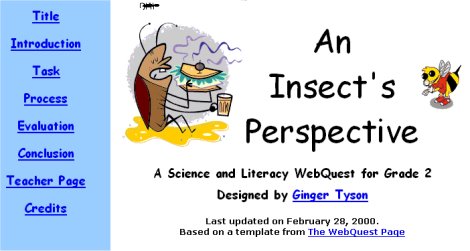Llengua anglesa a primària. Competència digital
- guia
- Mòdul 0
- Mòdul 1
- Mòdul 2
- Mòdul 3
- Mòdul 4
- Mòdul 5
- Mòdul 6
- projecte
- índex
An Insect’s Perpective. Webquest
A WebQuest is an inquiry-oriented lesson format in which most or all the information that learners work with comes from the web. The model was developed by Bernie Dodge at San Diego State University in 1995. All webquests follow the same structure:
- Introduction: a short paragraph to introduce the activity or lesson to the students. It is also in this section that you’ll communicate the Big Question that the whole WebQuest is centered around.
- Task: describes clearly what the final result of the learners’ activities will be. The task could be a problem or mystery to be solved, a product to be designed or anything that requires the learners to process and transform the information they have gathered.
- Process: presents the steps the learners should go through to accomplish the task. In the Process block, you might also provide some guidance on how to organize the information gathered.
- Evaluation: describes to the learners how their performance will be evaluated.
- Conclusion: summarizes what they will have accomplished or learned by completing this activity or lesson.
- Credits and References: sources of any images, music or text that you are using. It provides links back to the original source.
- Teachers page: describes briefly what the lesson is about, the grade level and course that the lesson is designed to cover; describes what students will learn as a result of this lesson and provides guidelines on how the webquest is organised.
The following webquest An Insect Perpective is an interdisciplinary -science and English- webquest developed by Ginger Tyson and suitable for cicle superior. Students will have a chance to work in cooperative groups to learn interesting facts about different insects. They will benefit from making group decisions about how insects are helpful to the environment.
Practice it!
- Go to the Webquests site on the Xtec → Primària → An Insect’s Perspective. (http://www.xtec.es/recursos/webquests/htm/insect.htm)
- Enter this webquest (http://projects.edtech.sandi.net/grant/insects/)
- First, they have to read the Introduction, it presents the situation. The objective is to investigate about insects and how they are necessary for humans.
- Second, they have to read the Task. They have to complete two tasks, write a letter and design a poster to prevent humans from destroying the insects habitat.
- Then, they have to go through the Process. It is divided into 5 steps:
- choose an insect,
- research the insect,
- have a group discussion,
- write a letter to Terminix and
- design a group poster.
- In the Evaluation part students can see the items of the teachers’ assessment.
- The Conclusion tells them about what they have learned.
- The Teacher Page is addressed to teachers, it explains the development of the webquest and give them some orientations in methodological aspects.
Activity framework
- Methodology: a webquest is a project to be done autonomously by the students. In this one they have to work in groups of four. Some of the tasks are to be done individually but there is a lot of group discussion and group work.
- Timing: This webquest needs at least 3 or 4 sessions.
- Resources: Computer room.
Additional info
For more information about webquests look at the WebQuest website in Recursos XTEC. It offers a wide range of webquests covering all subjects and levels and also reference links related to this topic like:
- Comunitat Catalana de WebQuests
- The WebQuest Page
- My WebQuest Page by Fina Dènia
- De mestr@ a mestre/a by Carme Barba Corominas




